Plasma Cell Myeloma
Clinical History: A 31-year-old man with back pain. X-Ray Chest: Lower thoracic paravertebral soft issue with trabeculated T9. Lungs are clear. Heart size within normal limit. No other obvious bony abnormality.
Clinical History: A 31-year-old man with back pain.
X-Ray Chest: Lower thoracic paravertebral soft issue with trabeculated T9. Lungs are clear. Heart size within normal limit. No other obvious bony abnormality.
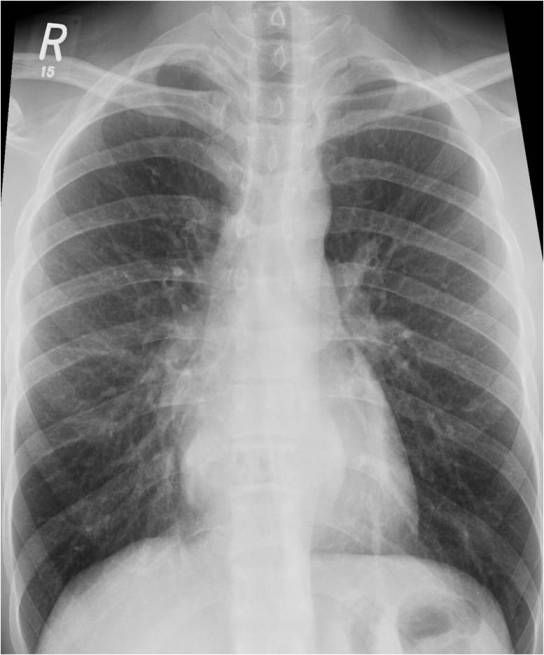
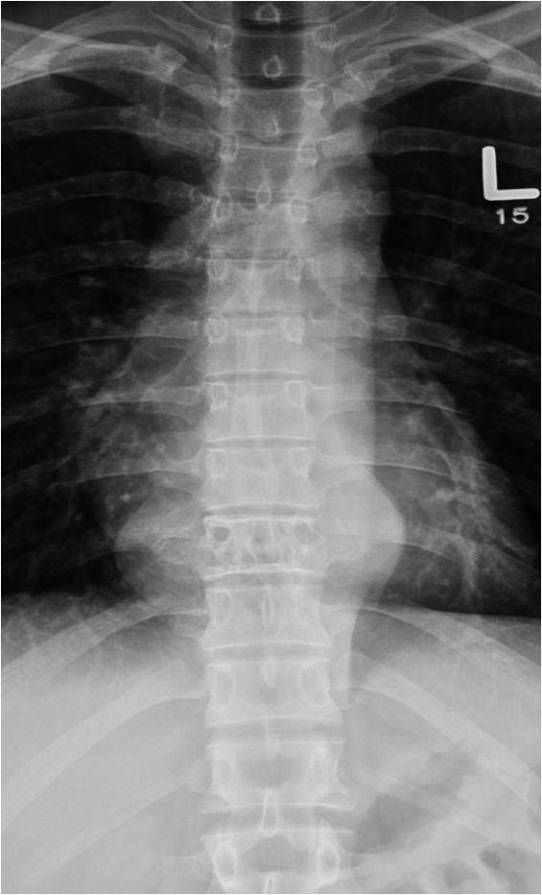
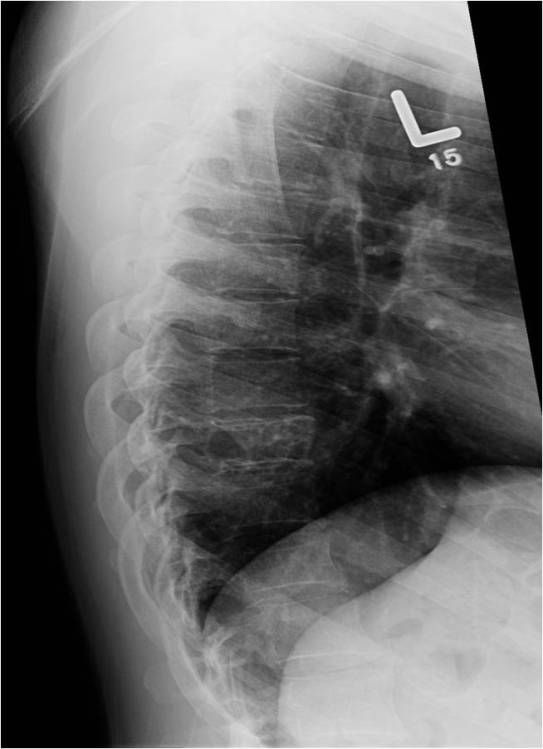
MRI Thoraco-lumbar spine:
The counting of the vertebrae was carried out from the lower lumbar vertebra. There is partly soft tissue and bony mass replacing the T9 vertebra with extension to the posterior element and spinous process with large paraspinal mass. The mass showed significant posterior epidural extension starting from T7 up to L1 causing severe cord compression with spinal cord signal changes. The mass showed high signal intensity on T1 and intermediate signal intensity on T2 with intermediate enhancement on post contrast study. There are other smaller focal lesions noted at T1, T3 and L4, suspicious for multifocal lesion. The rest of the vertebrae showed generalized heterogeneous signal changes.
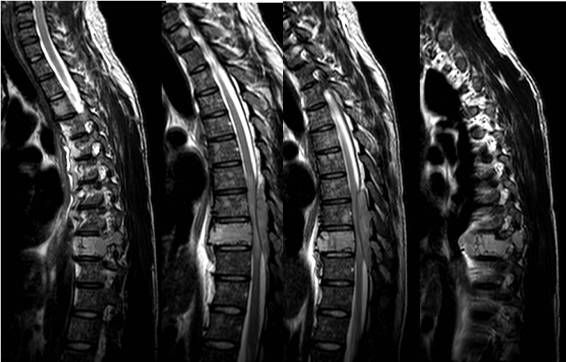
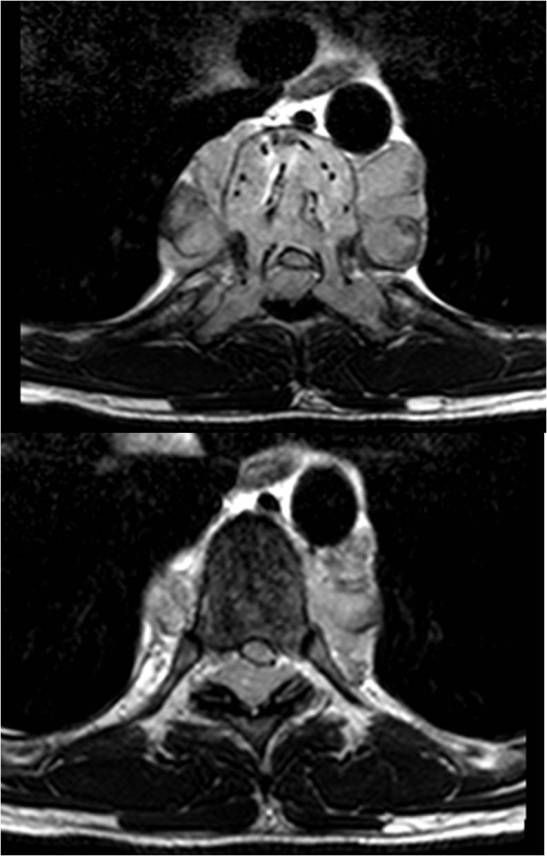
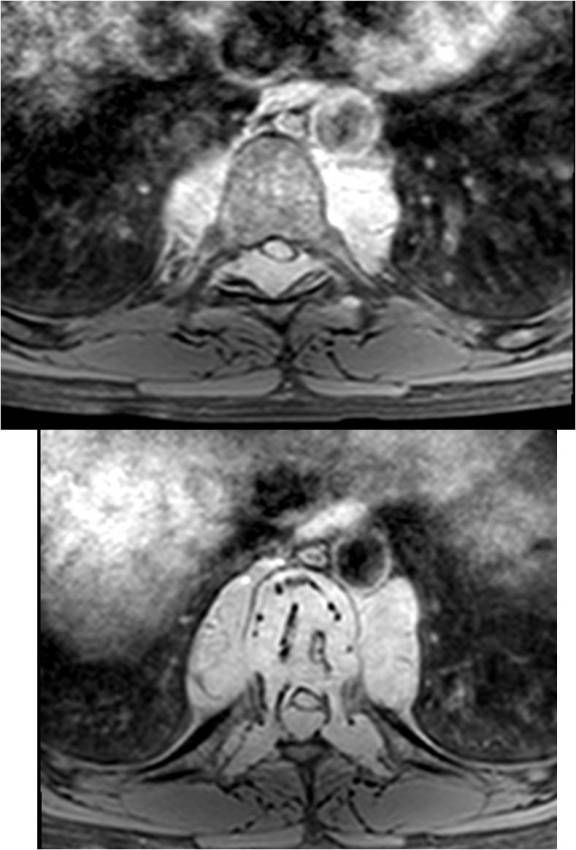
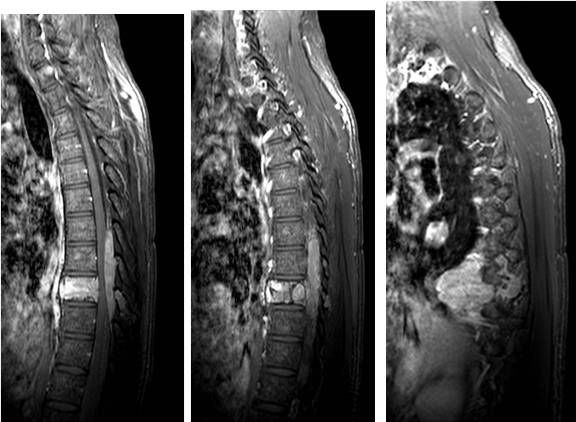
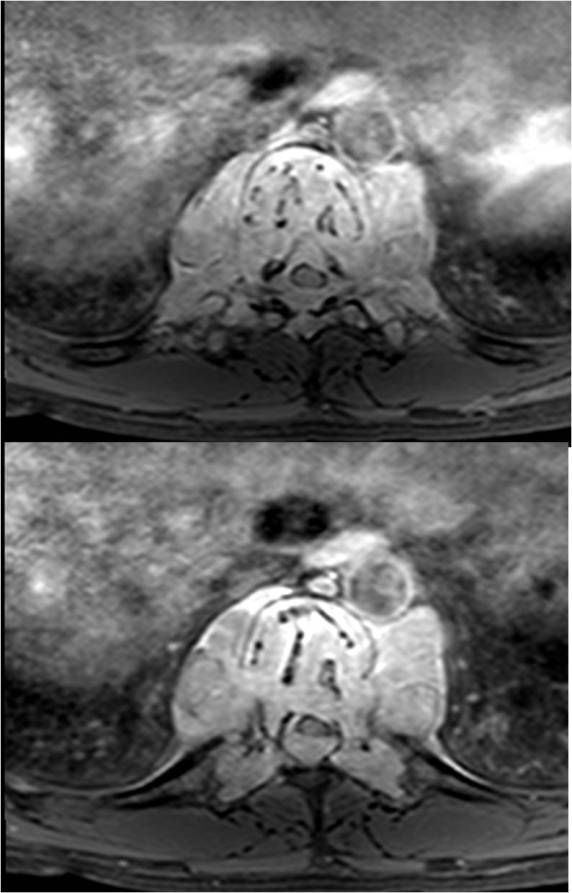
The overall findings are suggestive of lymphoma. However, possibility of metastatic deposits cannot be excluded. Pathology: Plasma Cell Myeloma
Follow-up MRI: After chemotherapy shows progressive improvement.

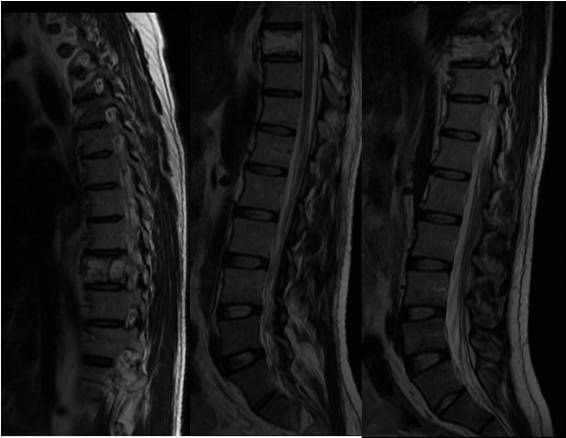
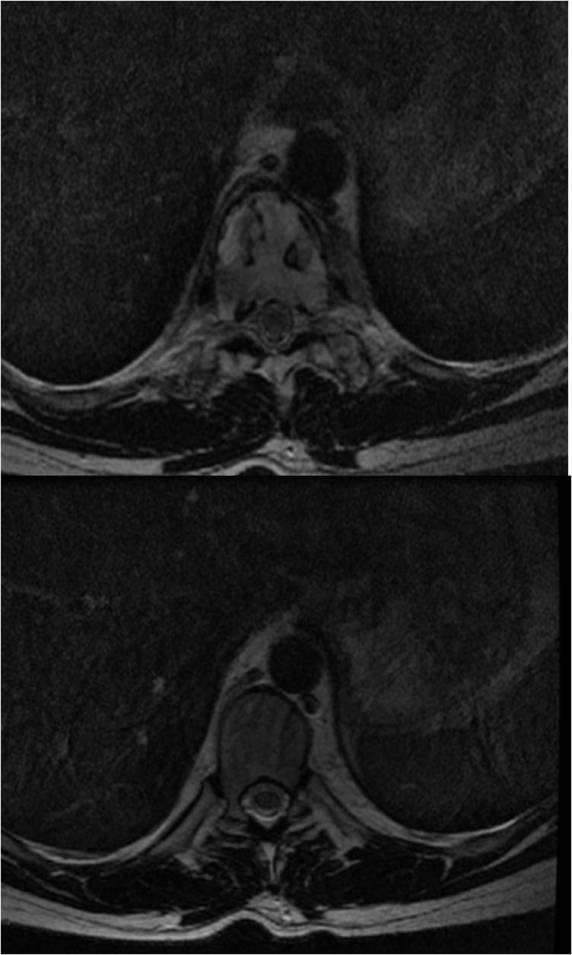

Plasma cell myeloma: (1) SYN: multiple myeloma. (2) plasmacytoma of bone, which is usually a solitary lesion and not associated with the occurrence of Bence Jones protein or other disturbances in the metabolism of protein (as observed in multiple myeloma). Some observers emphasize that the solitary lesion probably represents an early phase of classic multiple myeloma, or an example of the latter in which only one focus is recognized.
Symptoms of Multiple Myeloma
The earliest indication of multiple myeloma is severe, constant back and rib pain that increases with exercise and may be worse at night. Arthritic symptoms may also occur: achiness, joint swelling, and tenderness, possibly from vertebral compression. Other effects include fever, malaise, slight evidence of peripheral neuropathy (such as peripheral paresthesia), and pathologic fractures. As multiple myeloma progresses, symptoms of vertebral compression may become acute, accompanied by anemia, weight loss, thoracic deformities (ballooning), and loss of body height due to vertebral collapse. Renal complications such as pyelonephritis (caused by tubular damage from large amounts of Bence Jones protein, hypercalcemia, and hyperuricemia) may occur. Severe, recurrent infection such as pneumonia may follow damage to nerves associated with respiratory function.
Common Signs and Symptoms
- Bone pain (often lower back, spine, and ribs)
- Broken bones or osteoporosis (pelvis, spine, ribs, and skull)
- Weakness/exhaustion/fatigue
- Loss of appetite
- Confusion
- Parched
- Fevers/Infections, especially pneumonia
- Weight loss
- Nausea/vomiting
- Constipation
- Abnormal frequency of urination
Other Signs and Symptoms
- Hyperviscosity syndrome (thickening of blood): signs include shortness of breath, confusion, or chest pain.
- Cryoglobulinemia: signs include pain and numbness in extremities in cold weather.
- Amyloidosis: signs include low blood pressure, numbness in extremities, and kidney, heart, or liver failure.
Associated Disorders
- Anemia
- Spinal cord compression
- Hypercalcemia, which often leads to renal damage
- Renal damage due to excess protein in the blood
- Impaired production of immogobulin
- Pain, tingling, and/or numbness
Diagnosis and Staging
Multiple myeloma is often discovered through routine blood tests or as a result of a broken bone. All myeloma patients will show a spike in M protein, which is produced by myeloma cells, in a blood or urine test. Also, both tests will identify poorly functioning immuglobulin, a sign of myeloma. A diagnosis typically requires one major (a positive biopsy; bone marrow with 30%+ plasma cells; or high MCIG levels) and one minor criterion (bone marrow with 10-30% plasma cells; minor MCIG levels; tumor holes in bones; or low antibody levels) or three minor criteria.
There are typically four tests commonly employed to diagnose multiple myeloma:
1. Blood tests: to check for high levels of proteins, low levels of white blood cells and/or platelets, high levels of calcium, and creatinine levels from the kidneys.
2. Urine tests: to check for high levels of Bence Jones proteins.
3. X-rays: to check for broken or thinning bones
4. Biopsies: to check tissue and/or bone marrow for cancerous cells.
Staging Multiple Myeloma
Staging involves figuring out how advanced multiple myeloma is by three tests.
1. Blood tests
2. CT scan
3. MRI
Stages
The stages of multiple myeloma are based on the levels of M protein, the number of bone lesions, the number of red blood cells, and calcium levels. These levels can also be subdivided into A and B based on the function of the kidney. Note that doctors are increasingly rejecting the Stage I-III system for case-by-case markers.
Stage I: Early disease with symptoms and some bone damage.
Stage II: More advanced symptoms and damage.
Stage III: Still more myeloma cells are found throughout the body.
Sushila Ladumor, MD, FRCR, Consultant Radiologist with Multi-modality Imaging experience, working in Medical Imaging Department, King Abdulaziz Medical City, Riyadh, Saudi Arabia.
References:
http://radiology.rsna.org/content/104/3/521.shorthttp://www.rightdiagnosis.com/medical/plasma_cell_myelomahttp://www.cancer.gov/cancertopics/pdq/treatment/myelomahttp://www.knowcancer.com/oncology/multiple-myeloma-or-plasma-cell-myeloma/http://www.pathologyoutlines.com/topic/lymphomamyeloma.html
Clarius Mobile Health Unveils Anterior Knee Feature for Handheld Ultrasound
April 23rd 2025The T-Mode Anterior Knee feature reportedly offers a combination of automated segmentation and real-time conversion of grayscale ultrasound images into color-coded visuals that bolster understanding for novice ultrasound users.
The Reading Room Podcast: Current Perspectives on the Updated Appropriate Use Criteria for Brain PET
March 18th 2025In a new podcast, Satoshi Minoshima, M.D., Ph.D., and James Williams, Ph.D., share their insights on the recently updated appropriate use criteria for amyloid PET and tau PET in patients with mild cognitive impairment.
What is the Best Use of AI in CT Lung Cancer Screening?
April 18th 2025In comparison to radiologist assessment, the use of AI to pre-screen patients with low-dose CT lung cancer screening provided a 12 percent reduction in mean interpretation time with a slight increase in specificity and a slight decrease in the recall rate, according to new research.